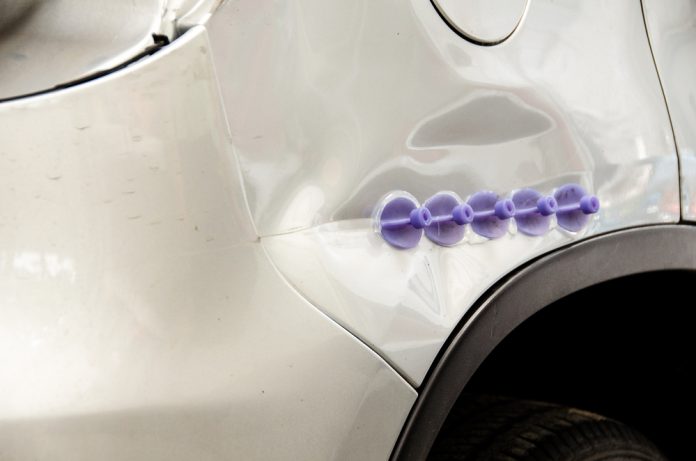Hailstorms are notorious for causing visible damage to vehicles, from small dents and dings to cracked windshields. However, one type of damage that often goes unnoticed is paint damage. Even minor hailstones can chip or scratch your vehicle’s paint, leaving it vulnerable to rust and corrosion if not repaired promptly. Spotting paint damage can be tricky because it might not always be obvious at first glance.
In this article, we’ll guide you through the process of identifying paint damage caused by hail, offering tips for proper inspection, and explaining why early detection is crucial for maintaining the value and appearance of your vehicle.
1. Inspect for Dents and Paint Chips
After a hailstorm, the first thing you should do is inspect your vehicle for any visible dents. Often, paint chips or scratches accompany dents, but these might not be immediately noticeable. The force of hailstones can chip away at the paint, particularly in areas where the vehicle’s body panels are thinner or more exposed.
Steps to Inspect for Dents and Chips:
- Look for Dents on Flat Surfaces: Start by checking the flat surfaces of your vehicle, such as the hood, roof, and trunk. These areas are most susceptible to hail damage. Focus on any dents that might have chipped the paint, leaving the underlying metal exposed.
- Examine Edges and Corners: Hail damage often occurs along the edges of panels, such as near the doors, fenders, or bumpers. The impact from the hail can chip the paint at these points, leading to more severe damage if left untreated.
- Check for Bare Metal: If you see bare metal where the paint has chipped away, this is a sign that hail has compromised the vehicle’s finish. Over time, these exposed areas can rust, especially if the vehicle is exposed to rain or humidity.
2. Examine the Clear Coat for Damage
Your vehicle’s clear coat serves as a protective layer over the paint, providing both gloss and protection against environmental damage. While the paint may appear intact, the clear coat might have been damaged by the hailstorm, leaving it vulnerable to further deterioration.
How to Spot Clear Coat Damage:
- Check for Uneven Shine: Under natural sunlight or a bright light source, look for any areas on the surface of your vehicle where the clear coat may appear dull or inconsistent. Hail impacts can cause the clear coat to crack or flake, leading to a patchy appearance.
- Look for Fine Cracks: Small cracks in the clear coat might not be easily visible without close inspection. Run your fingers lightly over the surface to feel for any areas where the texture seems rougher or more uneven than usual. These could be signs that the clear coat has been compromised.
3. Inspect for Scratches on the Vehicle’s Body Panels
Hail can sometimes be driven sideways by wind, causing it to scrape against the surface of your vehicle. This can result in scratches across the body panels, which might not be immediately visible, especially if they are shallow.
How to Check for Scratches:
- Look for Horizontal or Diagonal Marks: Pay close attention to the sides of the vehicle, particularly the doors and fenders, where sideways-driven hail may have left scratches. The impact may have caused the paint to scrape away in thin lines.
- Use a Bright Light: Shallow scratches may not be visible in low light, so it’s important to use a bright flashlight or inspect the car in direct sunlight. Move the light around the surface to detect any imperfections that could indicate hail-induced scratches.
4. Use the Right Lighting for a Thorough Inspection
Good lighting is essential for spotting paint damage, especially in areas where the damage might be subtle. Natural sunlight is ideal, but if you’re inspecting the vehicle in a garage or shaded area, a bright LED flashlight can also work well.
Tips for Proper Lighting:
- Inspect in Natural Sunlight: The best way to detect paint damage is to inspect your vehicle under natural sunlight. The sun’s reflection will highlight any imperfections or inconsistencies in the paint.
- Move the Light Source Around: If you’re using a flashlight, move the light source around at different angles to ensure you capture all potential damage. Look for any reflections that seem distorted, which can indicate damage to the paint or clear coat.
5. Feel for Rough Spots or Inconsistencies
In some cases, paint damage may not be immediately visible to the naked eye, but you can often feel it by running your fingers lightly over the vehicle’s surface. Rough or uneven spots can indicate that the paint has been chipped or scratched.
How to Perform a Tactile Inspection:
- Run Your Hand Over the Surface: Gently glide your hand over the vehicle’s body panels. If you feel any rough patches, bumps, or areas where the paint feels uneven, this could be a sign of paint damage from hail.
- Check for Raised Edges: If you notice any raised edges around dents, this could indicate that the paint has started to peel or chip away around the impact area.
6. Why Early Detection of Paint Damage Matters
Detecting paint damage early is crucial for preventing further problems, such as rust or corrosion, which can lead to more expensive repairs down the road. Once the paint and clear coat are compromised, your vehicle’s metal body panels are left exposed to the elements.
Long-Term Risks of Ignoring Paint Damage:
- Rust and Corrosion: Without the protective barrier of paint and clear coat, your vehicle’s metal body panels can rust when exposed to moisture. Rust can spread quickly, leading to structural damage that’s far more costly to repair than a simple paint touch-up.
- Decreased Resale Value: Paint damage, especially if left unaddressed, can significantly reduce your vehicle’s resale value. Buyers are often wary of purchasing vehicles with visible damage, as it suggests that the car hasn’t been well-maintained.
7. What to Do If You Find Paint Damage
If you discover paint damage after a hailstorm, it’s important to act quickly to prevent the problem from worsening. Here’s what you should do next:
Steps to Take:
- Document the Damage: Take clear, high-resolution photos of any paint damage you find. This documentation will be important if you plan to file an insurance claim.
- Contact Your Insurance Company: If you have comprehensive insurance coverage, contact your insurance provider to report the damage. They may send an adjuster to assess the extent of the damage and provide an estimate for repairs.
- Get Professional Repairs: For paint damage, it’s best to seek out a professional auto body shop that specializes in hail damage repair. In many cases, Paintless Dent Repair (PDR) can fix the dents without affecting the paint. If the paint is damaged, the shop may need to repaint the affected area to restore it to its original condition.
Conclusion
Hailstorms can cause more than just dents and dings; they can also damage your vehicle’s paint, leaving it vulnerable to rust and corrosion. By inspecting your vehicle thoroughly after a storm and identifying any paint damage early, you can prevent long-term issues and maintain the value of your car. Whether it’s small chips, scratches, or compromised clear coat, addressing paint damage promptly ensures your vehicle remains in top condition for years to come.







